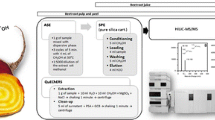Abstract
The importance of dietary betaine is increasingly recognized. The aim of this study was to develop a simple high-performance liquid chromatography with standard ultraviolet spectrometric detection (HPLC-UV) method for betaine (N,N,N-trimethylglycine) determination in foods after derivatization. Two methods were used for betaine derivatization. Thereafter, derivatized betaine was quantified using HPLC-UV, and the results were compared with liquid chromatography mass spectrometry (LC-MS). The established derivatizing agent 2′-naphthacyl triflate and a novel derivatizing agent 2-bromo-2′-acetonaphthone produced the same cationic derivative when they react with betaine. The calibration curves were linear up to 1000 μmol/L (R 2 = 0.9974 for 2′-naphthacyl triflate and 0.9995 for 2-bromo-2′-acetonaphthone). The limit of detection was 1 μmol/L for both methods (2′-naphthacyl triflate and 2-bromo-2′-acetonaphthone), confirming sufficient sensitivity for betaine quantification in foods. The average recovery from different food matrices (wheat flour and spinach) (n = 12) was 99 ± 9 %, 95 ± 10 %, and 101 ± 8 % for LC-MS, 2′-naphthacyl triflate, and 2-bromo-2′-acetonaphthone, respectively. Inter- and intra-assay coefficients of variation (CVs) in the control samples (whole wheat flour) were below 10 %. Quantitative results for foods analyzed using 2′-naphthacyl triflate and 2-bromo-2′-acetonaphthone were comparable to LC-MS (R 2 = 0.992 and 0.990), respectively. The highest betaine content (~160 mg/100 g) was found in spinach followed by faba bean, wheat flour, and beetroot. These methods can be widely used for betaine quantification because of the simplicity of the derivatization procedures, and the commercial availability of the derivatizing reagent (2-bromo-2′-acetonaphthone) or through the relatively easy synthesis of 2-naphthacyl triflate.






Similar content being viewed by others
References
Ahmad R, Lim C, Kwon S-Y (2013) Glycine betaine: a versatile compound with great potential for gene pyramiding to improve crop plant performance against environmental stresses. Plant Biotechnol Rep 7(1):49–57
Bruce SJ, Guy PA, Rezzi S, Ross AB (2010) Quantitative measurement of betaine and free choline in plasma, cereals and cereal products by isotope dilution LC-MS/MS. J Agric Food Chem 58(4):2055–2061. doi:10.1021/jf903930k
Burg MB, Ferraris JD, Dmitrieva NI (2007) Cellular response to hyperosmotic stresses. Physiol Rev 87(4):1441–1474. doi:10.1152/physrev.00056.2006
Corol D-I, Ravel C, Raksegi M, Bedo Z, Charmet G, Beale MH et al (2012) Effects of genotype and environment on the contents of betaine, choline, and trigonelline in cereal grains. J Agric Food Chem 60(21):5471–5481. doi:10.1021/jf3008794
de Zwart FJ, Slow S, Payne RJ, Lever M, George PM, Gerrard JA et al (2003) Glycine betaine and glycine betaine analogues in common foods. Food Chem 83(2):197–204. doi:10.1016/S0308-8146(03)00063-3
Detopoulou P, Panagiotakos DB, Antonopoulou S, Pitsavos C, Stefanadis C (2008) Dietary choline and betaine intakes in relation to concentrations of inflammatory markers in healthy adults: the ATTICA study. Am J Clin Nutr 87(2):424–430
Dilger RN, Garrow TA, Baker DH (2007) Betaine can partially spare choline in chicks but only when added to diets containing a minimal level of choline. J Nutr 137(10):2224–2228
Graham SF, Hollis JH, Migaud M, Browne RA (2009) Analysis of betaine and choline contents of aleurone, bran, and flour fractions of wheat (Triticum aestivum L.) using 1H nuclear magnetic resonance (NMR) spectroscopy. J Agric Food Chem 57(5):1948–1951. doi:10.1021/jf802885m
Happer DAR, Hayman CM, Storer MK, Lever M (2004) Aracyl triflates as derivatizing agents for biological betaines. Aust J Chem 57(5):467–472. doi:10.1071/CH03133
Koc H, Mar M-H, Ranasinghe A, Swenberg JA, Zeisel SH (2002) Quantitation of choline and its metabolites in tissues and foods by liquid chromatography/electrospray ionization-isotope dilution mass spectrometry. Anal Chem 74(18):4734–4740. doi:10.1021/ac025624x
Lang F (2007) Mechanisms and significance of cell volume regulation. J Am Coll Nutr 26(5):613S–623S
Laryea MD, Steinhagen F, Pawliczek S, Wendel U (1998) Simple method for the routine determination of betaine and N, N-dimethylglycine in blood and urine. Clin Chem 44(9):1937–1941
Lenky CC, McEntyre CJ, Lever M (2012) Measurement of marine osmolytes in mammalian serum by liquid chromatography-tandem mass spectrometry. Anal Biochem 420(1):7–12. doi:10.1016/j.ab.2011.09.013
Lever M, Slow S (2010) The clinical significance of betaine, an osmolyte with a key role in methyl group metabolism. Clin Biochem 43(9):732–744. doi:10.1016/j.clinbiochem.2010.03.009
Price RK, Keaveney EM, Hamill LL, Wallace JMW, Ward M, Ueland PM et al (2010) Consumption of wheat aleurone-rich foods increases fasting plasma betaine and modestly decreases fasting homocysteine and LDL-cholesterol in adults. J Nutr 140(12):2153–2157. doi:10.3945/jn.110.126961
Sakamoto A, Nishimura Y, Ono H, Sakura N (2002) Betaine and homocysteine concentrations in foods. Pediatr Int 44(4):409–413
Schliess F, Haussinger D (2002) The cellular hydration state: a critical determinant for cell death and survival. Biol Chem 383(3–4):577–583
Slow S, Elmslie J, Lever M (2008) Dietary betaine and inflammation. Am J Clin Nutr 88(1):247–248
Slow S, Lever M, Chambers ST, George PM (2009) Plasma dependent and independent accumulation of betaine in male and female rat tissues. Physiol Res 58(3):403–410
Storer MK, Lever M (2006) Aracyl triflates for preparing fluorescent and UV absorbing derivatives of unreactive carboxylates, amines and other metabolites. Anal Chim Acta 558(1–2):319–325
Storer MK, McEntyre CJ, Lever M (2006) Separation of cationic aracyl derivatives of betaines and related compounds. J Chromatogr A 1104(1–2):263–271. doi:10.1016/j.chroma.2005.11.123
Zeisel SH, Mar M-H, Howe JC, Holden JM (2003) Concentrations of choline-containing compounds and betaine in common foods. J Nutr 133(5):1302–1307
Acknowledgments
Scholarship funding from the Partner Ownership initiative program (ParOwn, grant number 20150), the Ministry of Higher Education, Egypt, is gratefully acknowledged. Assistance from the National Heart Foundation of New Zealand and from the Maurice & Phyllis Paykel Trust is also acknowledged.
Conflict of Interest
Mohammed Hefni declares that he has no conflict of interest. Christopher McEntyre declares he has no conflict of interest. Michael Lever declares that he has no conflict of interest. Sandy Slow declares she has no conflict of interest. This article does not contain any studies with human or animal subjects.
Author information
Authors and Affiliations
Corresponding author
Rights and permissions
About this article
Cite this article
Hefni, M., McEntyre, C., Lever, M. et al. Validation of HPLC-UV Methods for the Quantification of Betaine in Foods by Comparison with LC-MS. Food Anal. Methods 9, 292–299 (2016). https://doi.org/10.1007/s12161-015-0195-6
Received:
Accepted:
Published:
Issue Date:
DOI: https://doi.org/10.1007/s12161-015-0195-6




